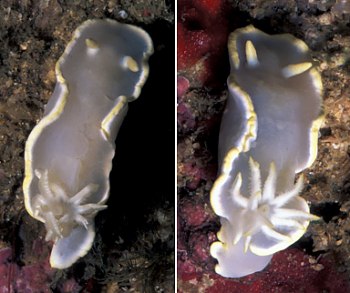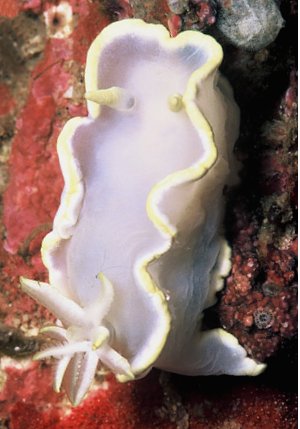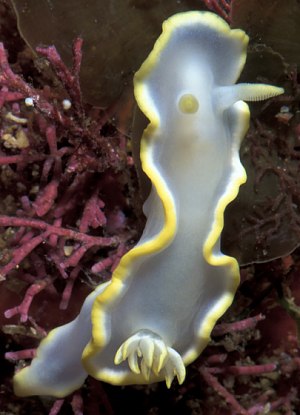Glossodoris sp. 12 from South Africa
September 23, 2002
From: Lindsay Warren

Dear Bill
Please find attached several shots of what I had been assuming were colour variants of Glossodoris sp. 4. But now, having looked at these and photos of what is much closer to G. sp. 4 (see separate message) I realise that this is highly unlikely. I read the comments about small specimens of ones similar to those in these shots possibly being juvenile Glossodoris pallida where the white notal markings have not developed. However, given the sizes of the ones here, I think this is unlikely. A specimen of G. pallida from the Tukang Besi Archipelago, SE Sulawesi measuring only 9mm (see separate message) already had clearly defined notal markings. I realise that there is a rather large geographic distance between this and the ones with this email but it seems strange that there should be such a difference in development in the same species. However, I do realise that external appearances do not always tell the whole story, so to speak!
These wee beasties were all found at different sites off Park Rynie, KwaZulu-Natal, South Africa:
Upper right: depth of 95ft by Valda Fraser and I on 21 December 2001. L: 22mm. [Specimens LCRW0045 and 0046]
Lower Left: depth of 100ft on also 21 December 2001. L: 30mm. [specimen LCRW0047]
Lower right: depth of 82ft on 10 March 2002. L: 28 mm. [specimen LCRW0094]
In all these the mantle edge is quite 'thick' with a distinct yellow line and the mantle glands are not distinct. In Glossodoris sp. 4 the mantle edge is thin, white only and distinctive radiating mantle glands are visible in both 20mm and 50mm specimens. Other features of this species are that the edge of the foot and the outer edge of the gills are lined in yellow. In Glossodoris sp. 4 they are lined in white although the gills do have a hint of yellow on the tips. Another difference is that the rhinophores in this species have translucent white bases with yellow clubs, while in Glossodoris sp. 4 the coloration is similar but the clubs also have a white line down the anterior 'edge.'
I would be interested to hear your thoughts on this and the others. All very confusing and probably not 'solvable' at the moment.
All the best
Lindsay
alldcl@compuserve.com


Dear Lindsay,
I am sure this 'species' will turn out to be distinct from Glossodoris sp. 4. Once the anatomy is studied I am sure we will find that it is the total colour pattern which is important. There are many white species with and without yellow borders but what really distinguishes them externally are the colours of the gills and rhinophores, and sometimes the general shape of the body and the gills. However I could of course be being over confident ....
At the moment I'll 'store' this as Glossodoris sp. 12.
Best wishes,
Bill Rudman
Related messages
-
Re: Glossodoris sp. 12 from Reunion
From: Hugues Flodrops, November 19, 2008 -
An unusual Glossodoris sp. 4
From: Valda Fraser, September 23, 2002
